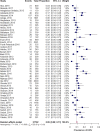Hepatitis B virus infection in Nigeria: a systematic review and meta-analysis of data published between 2010 and 2019
- PMID: 34717586
- PMCID: PMC8556927
- DOI: 10.1186/s12879-021-06800-6
Hepatitis B virus infection in Nigeria: a systematic review and meta-analysis of data published between 2010 and 2019
Abstract
Background: Hepatitis B virus (HBV) is an infectious disease of global significance, causing a significant health burden in Africa due to complications associated with infection, such as cirrhosis and liver cancer. In Nigeria, which is considered a high prevalence country, estimates of HBV cases are inconsistent, and therefore additional clarity is required to manage HBV-associated public health challenges.
Methods: A systematic review of the literature (via PubMed, Advanced Google Scholar, African Index Medicus) was conducted to retrieve primary studies published between 1 January 2010 and 31 December 2019, with a random-effects model based on proportions used to estimate the population-based prevalence of HBV in the Nigerian population.
Results: The final analyses included 47 studies with 21,702 participants that revealed a pooled prevalence of 9.5%. A prevalence estimate above 8% in a population is classified as high. Sub-group analyses revealed the highest HBV prevalence in rural settings (10.7%). The North West region had the highest prevalence (12.1%) among Nigeria's six geopolitical zones/regions. The estimate of total variation between studies indicated substantial heterogeneity. These variations could be explained by setting and geographical region. The statistical test for Egger's regression showed no evidence of publication bias (p = 0.879).
Conclusions: We present an up-to-date review on the prevalence of HBV in Nigeria, which will provide critical data to optimise and assess the impact of current prevention and control strategies, including disease surveillance and diagnoses, vaccination policies and management for those infected.
© 2021. The Author(s).
Conflict of interest statement
The authors declare that they have no competing interests.
Figures




References
-
- World Health Organisation. Hepatitis B key facts. 2021. https://www.who.int/newsroom/factsheets/detail/hepatitis-b. Accessed 29 Sept 2021.
-
- Global Burden of Disease Mortality and Causes of Death Collaborators Global, regional, and national age-sex specific all-cause and cause-specific mortality for 240 causes of death, 1990–2013: a systematic analysis for the Global Burden of Disease Study 2013. Lancet. 2013;385(9963):117–171. - PMC - PubMed
-
- Global Burden of Disease Collaborative Network. Global Burden of Disease Study 2010 (GBD 2010) results by cause 1990–2010. Institute for Health Metrics and Evaluation (IHME). http://ghdx.healthdata.org/record/ihme-data/gbd-2010-results-cause-1990-.... Accessed 5 Feb 2021.
-
- World Health Organisation. Global health sector strategy on viral hepatitis, 2016–2021. 2016. https://apps.who.int/iris/bitstream/handle/10665/246177/WHO-HIV-2016.06e.... Accessed 27 Jan 2021.
-
- World Health Organisation. Hepatitis. Sixty-seventh world health assembly. Agenda item 12.3. May 24, 2014. http://apps.who.int/gb/ebwha/pdf_files/wha67/a67_r6-en.pdf?ua=1. Accessed 18 Jan 2021.
Publication types
MeSH terms
Substances
Grants and funding
LinkOut - more resources
Full Text Sources
Other Literature Sources
Medical

